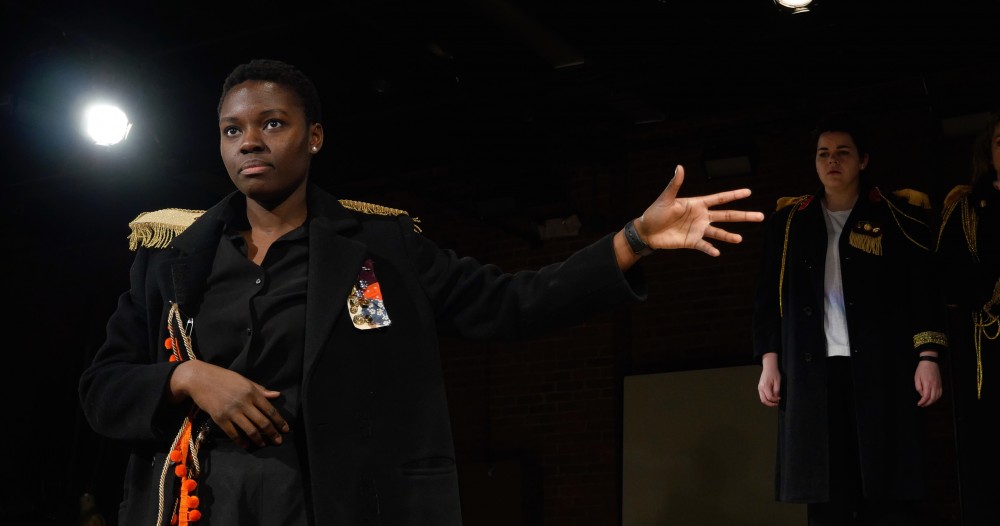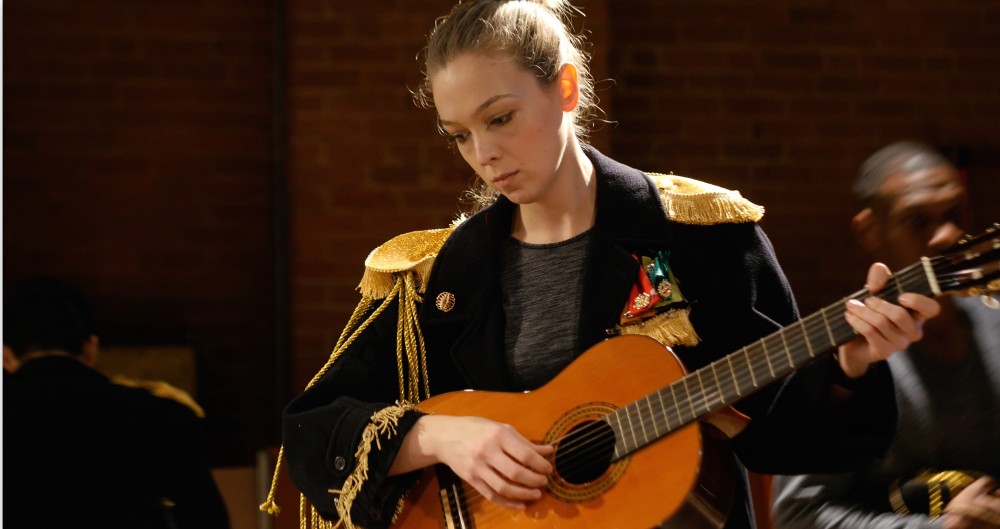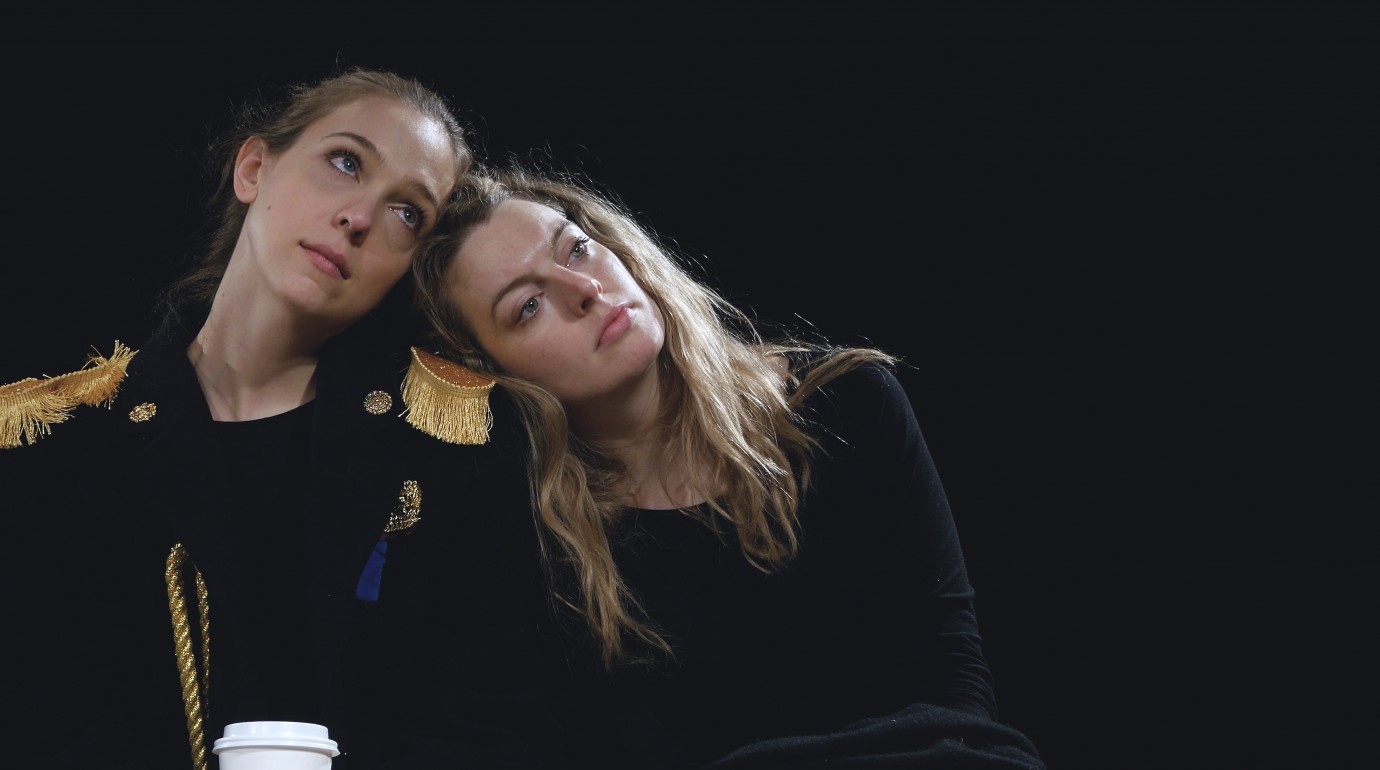NEW HAVEN, CONN.: In the lounge of a hotel across the street from Yale’s Iseman Theater, Dmitry Krymov is holding up a wine list, but he’s not looking for something to drink. The Russian director has the full attention of everyone sitting around him: His translator, Tatyana Khaikin, sits on his right, and Liz Diamond, chair of the directing program at Yale School of Drama, sits across from him.
Krymov motions to the top of the menu. “Here you have backstage,” he says, speaking in Russian that is immediately translated by Khaikin. Krymov flips the menu over. “Here you have the stage, and the actors onstage,” he says. He flips it back over. “Here is an actor backstage,” he continues. “He is like an ant who knows his route. To watch that route is fascinating.”
Krymov is describing The Square Root of Three Sisters, a collaboration with the Yale School of Drama, which represents Krymov’s first English-language production, and which runs June 21-25 as part of New Haven’s International Festival of Arts & Ideas. (The festival wraps up its three-week run this weekend.) The show is based on Chekhov’s Three Sisters, and follows a theatre troupe as they attempt to put on a production of the play.
In the story of a group of actors staging a production of Three Sisters, Krymov sees parallels to the play itself. Both Chekhov’s world and the structure of his most famous plays mirror the world of making theatre, insists Krymov. There is “the arrival, where everybody is excited and they’re meeting,” he says, then “love scenes with dialogue and confessions,” and finally “saying goodbye, or farewell—sometimes goodbye, sometimes farewell.” He looks out the window for a moment toward the theatre. “When we say goodbye every day after rehearsal,” he says, “We catch ourselves, because we are saying Chekhov’s word: goodbye.”

In Square Root, the performers portray both actors and actors playing characters from Chekhov’s plays. “There’s a very fashionable design where you have all of the seams outside,” Krymov says, referring to the work of Japanese fashion designer Yohji Yamamoto. “You don’t know what is the inside and what is the outside.” That, he says, sums up the experience of Square Root: You don’t know when the actors are playing their characters as just actors or actors playing Chekhovian roles. The lines begin to blur.
For Krymov, Square Root is an attempt to distill the characters and themes that Chekhov presents in his plays. “Chekhov was a doctor,” he explains. “He took X-rays and MRI scans and told us, ‘This is what is wrong with society.’ He grabbed something in human relations, and it’s always tragic. There is no happiness in [his] world. Love exists, but it doesn’t lead to happiness. It leads to destruction. But people do want to love. And this is the square root, the root of all of his plays—the nerve that he’s trying to explore. That is what makes him who he is.”
It is this root—this Chekhovian essence—that Krymov, along with a company that includes members from both the Yale School of Drama and Moscow’s Dmitry Krymov Laboratory, is trying to conjure in Square Root. Yale’s Diamond, who was responsible for bringing Krymov to Yale, says of her first experience of Krymov’s work, “I was taken by a bunch of friends to this old palace on some side street in Moscow. I went upstairs to an old, beautiful ballroom, sat on a church pew, and saw Donkey Hot. There was something in what he was doing that I thought touched the heart of what I want theatre to be. And I wanted more.”
What began with a master class in 2015 became a workshop in 2016, and finally a full-blown collaboration this spring. The International Festival of Arts & Ideas, which this year offered an eclectic selection of performances ranging from dancers Wendy Whelan and Brian Brooks to funk icon George Clinton and Parliament Funkadelic, offered the perfect home for Krymov, whose heavily movement- and image-based productions blur the line between theatre and other types of performance.

Krymov, who wrote the Square Root script, developed the play alongside the students. “I’ve never seen a process where the roles were written onto the actors more than this,” says Kevin Hourigan, a second-year MFA candidate, who performs in the play. Hourigan is speaking at a café down the street from the Iseman, and is accompanied by fellow actors Shaunette Renée Wilson and Melanie Field, both recent graduates of the Yale School of Drama. Although Hourigan acts in the production (his MFA concentration is in directing), mixing roles is not unusual for Krymov, whose own training was in painting and set design.
“Something about him operates on another level, and that just makes you want to be involved,” says Field. Wilson agrees: “There’s something very childlike and innocent that he’s interested in finding within each of the characters. The humor and innocence opens up for the audience to feel more for them—to feel sorry or to want to love them.”
Hourigan seconds the point about humor. “I think that [Krymov] earns his sense of humor because he has such deep respect for the work,” he says. “The magic of the show is that this ensemble of performers almost seems to accidentally stumble into transcendence.”
The actors didn’t have any difficulty adjusting to working with Krymov, who was always accompanied by Khaikin to translate in rehearsals. “There are some things that transcend language,” says Wilson. Field agrees: “There’s a universal language. I feel we’ve tapped into a shared knowledge of the human spirit and soul.”
Back in the hotel lounge, Krymov says something similar. “When they’re speaking Chekhov’s text, I understand it—I even make notes and correct them, even though they’re speaking in English,” he explains. “Theatre people from all over the world, from anywhere, we’re one big family and we understand each other. That was a very rich discovery.”
Krymov has clearly influenced his actors, even outside of the rehearsal room. As Field considers how to express a certain specific element of the show, a thought occurs to her all of a sudden. She reaches out and picks up a fork and spoon, holding them up with one in each hand. “Here,” she says, “I’ll show you.”


